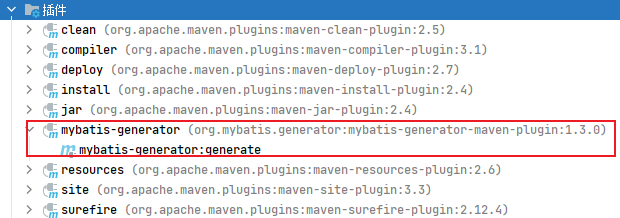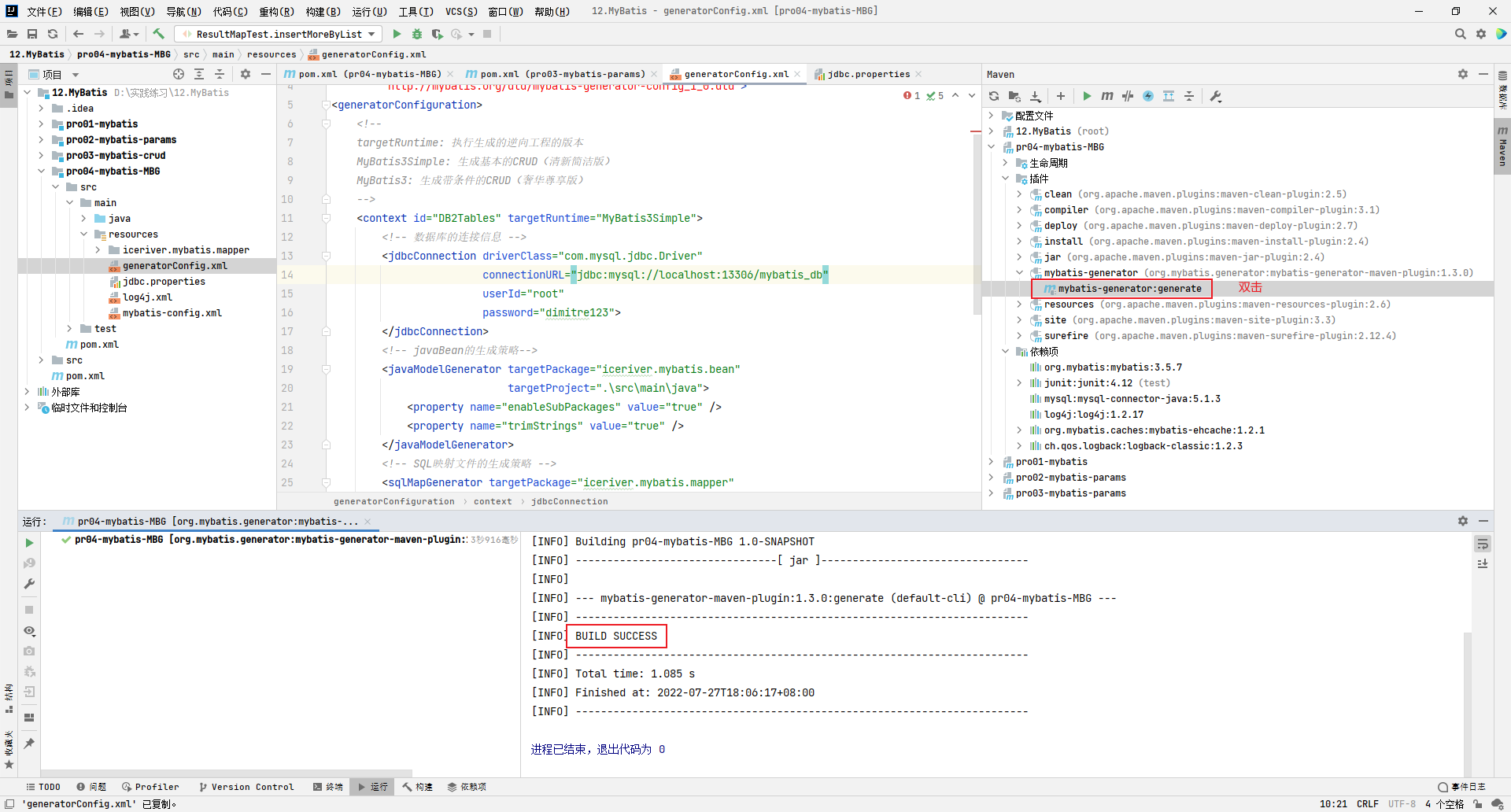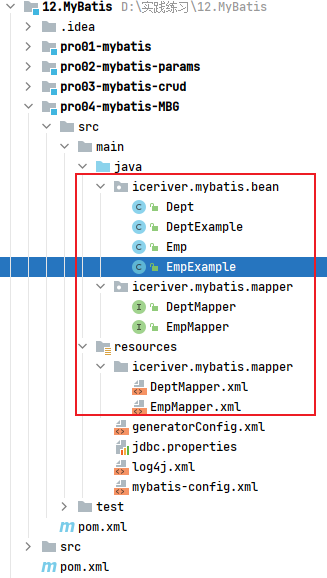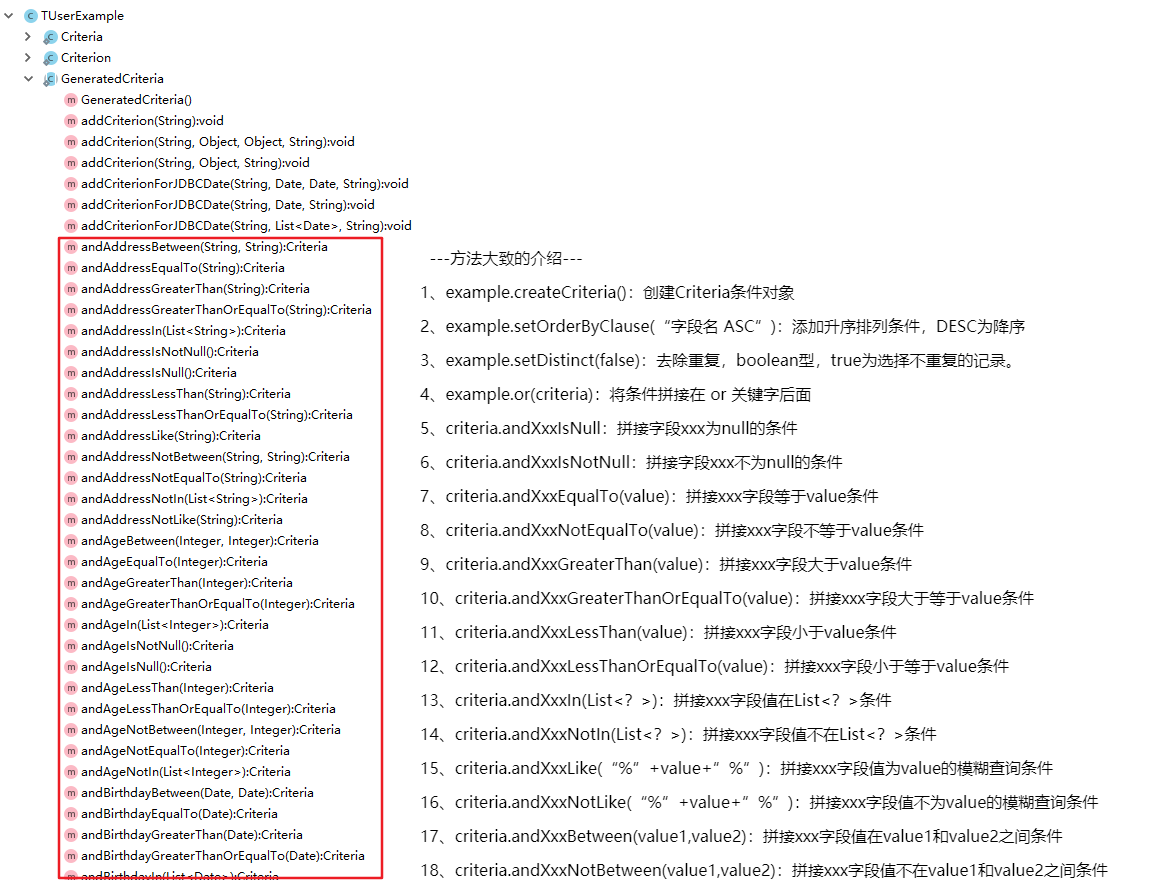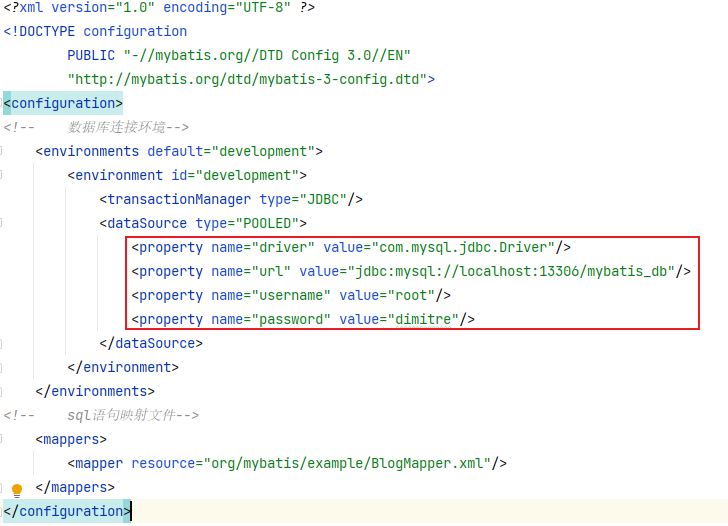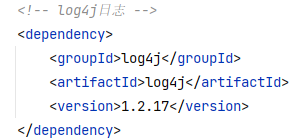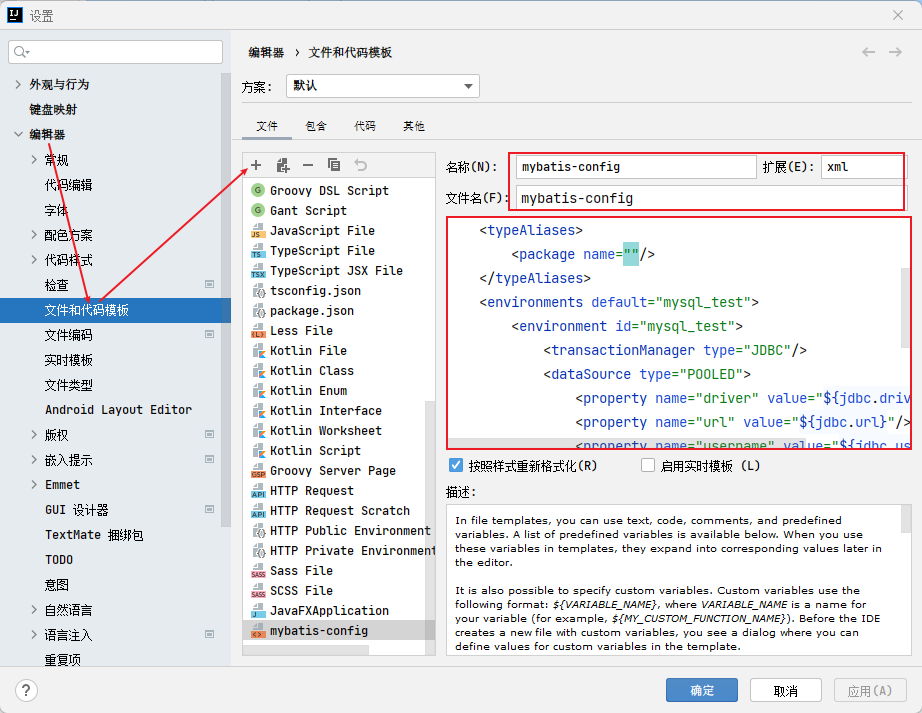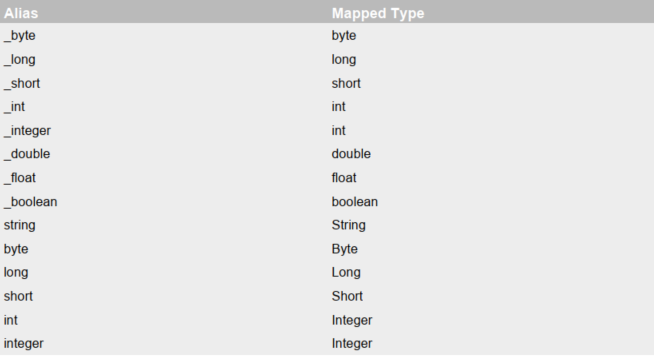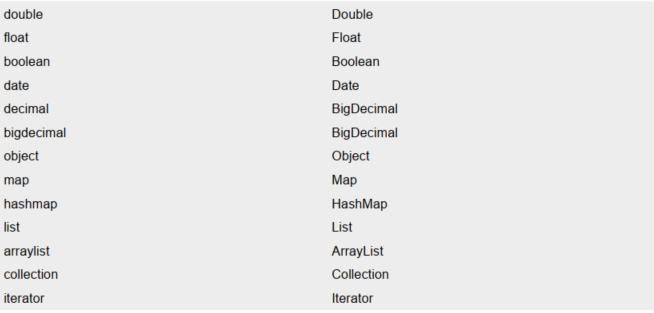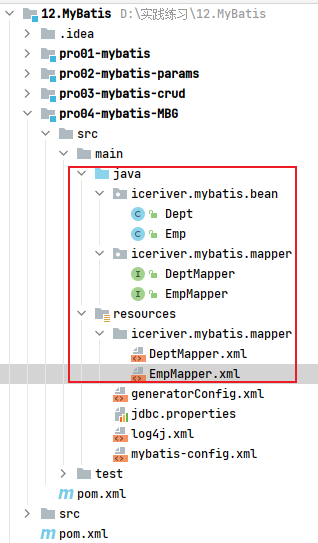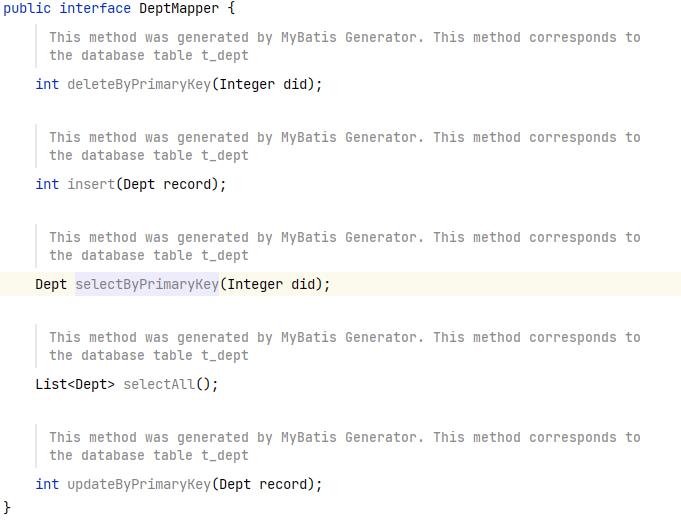MyBatis 是一款优秀的持久层框架,它支持自定义 SQL、存储过程以及高级映射。MyBatis 免除了几乎所有的 JDBC 代码以及设置参数和获取结果集的工作。MyBatis 可以通过简单的 XML 或注解来配置和映射原始类型、接口和 Java POJO(Plain Old Java Objects,普通老式 Java 对象)为数据库中的记录。
与 Spring、SpringMVC 无先后学习关系
需要 JDBC 基础
MyBatis 最初是 Apache 的一个开源项目 iBatis, 2010 年 6 月这个项目由 Apache Software Foundation 迁移到了 Google Code。随着开发团队转投 Google Code 旗下, iBatis3.x 正式更名为 MyBatis。代码于 2013 年 11 月迁移到 Github。
iBatis 一词来源于“internet”和“abatis”的组合,是一个基于 Java 的持久层框架。 iBatis 提供的持久层框架包括 SQL Maps 和 Data Access Objects(DAO)。
MyBatis 是支持定制化 SQL、存储过程以及高级映射的优秀的持久层框架。
MyBatis 避免了几乎所有的 JDBC 代码和手动设置参数以及获取结果集。
MyBatis 可以使用简单的 XML 或注解用于配置和原始映射,将接口和 Java 的 POJO(Plain Old Java Objects,普通的 Java 对象)映射成数据库中的记录。
MyBatis 是一个 半自动的ORM(Object Relation Mapping)框架。
MyBatis 的配置文件分为核心配置文件和映射配置文件,核心配置文件写项目数据库连接和 MyBatis 的全局配置,映射配置写 SQL 语句。
MyBatis 下载地址:https://github.com/mybatis/mybatis-3/releases
JDBC:
SQL 夹杂在 Java 代码中耦合度高,导致硬编码内伤
维护不易且实际开发需求中 SQL 有变化,频繁修改的情况多见
代码冗长,开发效率低
Hibernate 和 JPA
操作简便,开发效率高
程序中的长难复杂 SQL 需要绕过框架
内部自动生产的 SQL,不容易做特殊优化
基于全映射的全自动框架,大量字段的 POJO 进行部分映射时比较困难。
反射操作太多,导致数据库性能下降 。
MyBatis
轻量级,性能出色
SQL 和 Java 编码分开,功能边界清晰。Java 代码专注业务、SQL 语句专注数据
开发效率稍逊于 HIbernate,但是完全能够接受
软件版本:
IDEA:2021.2.4【与 3.8.6 版本的 Maven 版本不兼容】
Maven:3.5.4
Mysql:5.7
MyBatis:3.5.7
创建 maven 工程:参见【Maven 4.Maven 】
项目结构:
修改pro01-mybatis打包方式:需要为 jar 包形式
<packaging>jar</packaging>
在父工程12.MyBits中添加项目依赖:
1 2 3 4 5 6 7 8 9 10 11 12 13 14 15 16 17 18 19 20 21 <dependencies > <dependency > <groupId > org.mybatis</groupId > <artifactId > mybatis</artifactId > <version > 3.5.7</version > </dependency > <dependency > <groupId > junit</groupId > <artifactId > junit</artifactId > <version > 4.12</version > <scope > test</scope > </dependency > <dependency > <groupId > mysql</groupId > <artifactId > mysql-connector-java</artifactId > <version > 5.1.3</version > </dependency > </dependencies >
创建 MyBatis 的核心配置文件:
在main/resources目录下创建配置文件,习惯命名为mybatis-config.xml(名称无要求),整合 Spring 后,该文件可省略。
官方文档Getting Started提供了配置文件的模板【正文3 页】
根据本地 MySQL 的配置,修改配置文件的内容。
创建 mapper 接口:
1 2 3 4 5 6 7 8 9 CREATE TABLE `t_user` ( `id` int (11 ) NOT NULL AUTO_INCREMENT, `username` varchar (20 ) DEFAULT NULL , `password` varchar (20 ) DEFAULT NULL , `age` int (11 ) DEFAULT NULL , `sex` char (1 ) DEFAULT NULL , `email` varchar (100 ) DEFAULT NULL , PRIMARY KEY (`id`) ) ENGINE= InnoDB DEFAULT CHARSET= utf8
1 2 3 4 5 6 7 8 9 10 11 12 13 14 15 16 17 18 19 20 21 22 23 24 25 26 27 28 29 30 31 32 33 34 35 36 37 38 39 40 41 42 43 44 45 46 47 48 49 50 51 52 53 54 55 56 57 58 59 60 61 62 63 64 65 66 67 68 public class User { private Integer id; private String username; private String password; private Integer age; private String sex; private String email; public User () { } public User (Integer id, String username, String password, Integer age, String sex, String email) { this .id = id; this .username = username; this .password = password; this .age = age; this .sex = sex; this .email = email; } public Integer getId () { return id; } public void setId (Integer id) { this .id = id; } public String getUsername () { return username; } public void setUsername (String username) { this .username = username; } public String getPassword () { return password; } public void setPassword (String password) { this .password = password; } public Integer getAge () { return age; } public void setAge (Integer age) { this .age = age; } public String getSex () { return sex; } public void setSex (String sex) { this .sex = sex; } public String getEmail () { return email; } public void setEmail (String email) { this .email = email; } }
创建 mapper 接口:
mapper 接口相当于 service 接口,但不需要提供实现类 ,实现类由 MyBatis 生成。
1 2 3 4 5 6 7 public interface UserMapper { int insertUser () ; }
创建 MyBatis 映射文件:
ORM:Object Relationship Mapping对象关系映射。
对象:Java 的实体类对象。
关系:关系型数据库。
映射:二者之间的对应关系 。
Java 与数据库的对应关系:
类<—>表
属性<—>字段/列
对象<—>记录/行
映射文件命名规则:
表所对应的实体类的类名+Mapper.xml
例如:表 t_user,映射的实体类为 User,所对应的映射文件为UserMapper.xml
一个映射文件对应一个实体类,对应一张表的操作
MyBatis 映射文件用于编写 SQL,访问以及操作表中的数据
MyBatis 映射文件存放的位置是src/main/resources/mappers目录下
官方文档Getting Started提供了映射文件的模板【正文4 页】
映射文件须与 mapper 接口文件保持两个一致:
映射文件的命名空间(namespace)和 mapper 接口的全类名和保持一致
映射文件中编写 SQL 的标签的 id 属性和 mapper 接口中方法的方法名保持一致
核心配置文件中引入映射文件:
执行测试:
在src/test/java下创建测试目录及测试文件
编写测试方法:
1 2 3 4 5 6 7 8 9 10 11 12 13 14 15 16 17 18 19 20 public class UserMapperTest { @Test public void testInsertUser () throws IOException { InputStream istream = Resources.getResourceAsStream("mybatis-config.xml" ); SqlSessionFactoryBuilder sqlSessionFactoryBuilder = new SqlSessionFactoryBuilder (); SqlSessionFactory sqlSessionFactory = sqlSessionFactoryBuilder.build(istream); SqlSession sqlSession = sqlSessionFactory.openSession(); UserMapper userMapper = sqlSession.getMapper(UserMapper.class); int result = userMapper.insertUser(); sqlSession.commit(); System.out.println(result); } }
获取sqlsession时传入参数true,即可设置为自动提交事务
SqlSession:代表Java程序和数据库之间的会话。(HttpSession是Java程序和浏览器之间的会话)SqlSessionFactory:是“生产”SqlSession的“工厂”。工厂模式:如果创建某一个对象,使用的过程基本固定,那么我们就可以把创建这个对象的相关代码封装到一个“工厂类”中,以后都使用这个工厂类来“生产”我们需要的对象。
在父工程pom.xml中加入依赖:
在子工程src/main/resources目录下创建log4j.xml 1 2 3 4 5 6 7 8 9 10 11 12 13 14 15 16 17 18 19 20 <?xml version="1.0" encoding="UTF-8" ?> <!DOCTYPE log4j :configuration SYSTEM "log4j.dtd" > <log4j:configuration xmlns:log4j ="http://jakarta.apache.org/log4j/" > <appender name ="STDOUT" class ="org.apache.log4j.ConsoleAppender" > <param name ="Encoding" value ="UTF-8" /> <layout class ="org.apache.log4j.PatternLayout" > <param name ="ConversionPattern" value ="%-5p %d{MM-dd HH:mm:ss,SSS}%m (%F:%L) \n" /> </layout > </appender > <logger name ="java.sql" > <level value ="debug" /> </logger > <logger name ="org.apache.ibatis" > <level value ="info" /> </logger > <root > <level value ="debug" /> <appender-ref ref ="STDOUT" /> </root > </log4j:configuration >
放到父工程src/main/resources目录下报错,不知道为什么。
<level value="debug" />中debug代表输出信息级别的高低
FATAL(致命)>ERROR(错误)>WARN(警告)>INFO(信息)>DEBUG(调试)输出的信息内容详细程度从右至左提高
1 2 3 4 <insert id ="insertUser" > insert into t_user values(null,'admin','123456',23,'女','12315415@qq.com') </insert >
1 2 3 4 <update id ="updateUser" > update t_user set username = 'guest' where id = 6 </update >
1 2 3 4 <delete id ="deleteUser" > delete from t_user where id = 8 </delete >
1 2 3 4 5 6 7 8 9 <select id ="getUserById" resultType ="iceriver.mybatis.pojo.User" > select * form t_user where id = 7 </select > <select id ="getAllUser" resultType ="iceriver.mybatis.pojo.User" > select * from t_user </select >
查询的标签 select 必须设置属性resultType或resultMap,用于设置实体类和数据库表的映射关系
resultType:自动映射,用于属性名和表中字段名一致的情况resultMap:自定义映射,用于一对多或多对一或字段名和属性名不一致的情况
当查询的数据为多条时,不能使用实体类作为返回值,只能使用集合,否则会抛出异常TooManyResultsException;但是若查询的数据只有一条,可以使用实体类或集合作为返回值
1 2 3 4 5 6 7 8 9 10 11 12 13 14 15 16 17 18 19 20 21 22 23 24 25 26 27 28 29 30 31 32 33 34 35 36 37 38 39 40 41 42 43 44 45 46 47 48 49 50 51 52 53 54 55 56 57 58 59 60 61 62 63 64 65 66 67 68 <?xml version="1.0" encoding="UTF-8" ?> <!DOCTYPE configuration PUBLIC "-//MyBatis.org//DTD Config 3.0//EN" "http://MyBatis.org/dtd/MyBatis-3-config.dtd" > <configuration > <properties resource ="jdbc.properties" /> <typeAliases > <package name ="iceriver.mybatis.pojo" /> </typeAliases > <environments default ="mysql_test" > <environment id ="mysql_test" > <transactionManager type ="JDBC" /> <dataSource type ="POOLED" > <property name ="driver" value ="${jdbc.driver}" /> <property name ="url" value ="${jdbc.url}" /> <property name ="username" value ="${jdbc.username}" /> <property name ="password" value ="${jdbc.password}" /> </dataSource > </environment > </environments > <mappers > <package name ="iceriver.mybatis.mapper" /> </mappers > </configuration >
核心配置文件中<configuration>的子标签必须按照固定的顺序书写:
properties?,settings?,typeAliases?,typeHandlers?,objectFactory?,objectWrapperFactory?,reflectorFactory?,plugins?,environments?,databaseIdProvider?,mappers?
核心配置文件模板:
映射文件模板:
${}字符串拼接
本质是字符串拼接
参数为字符串类型或日期类型的字段进行赋值时,需要手动加单引号
#{}占位符【优先使用】
本质是占位符赋值
参数为字符串类型或日期类型的字段进行赋值时,可以自动添加单引号
#{param}:param 名称任意,建议见明知意'${param}':param 名称任意,建议见明知意;注意单引号''。
若 mapper 接口中的方法参数为多个时,此时 MyBatis 会自动将这些参数放在一个 map 集合中,以arg0,arg1.…为键,以参数为值;以param1,param2…为键,以参数为值;
因此只需要通过${}和#{}访问 map 集合的键就可以获取相对应的值。
arg0和param1可以混用,但要注意先后顺序。
若 mapper 接口中的方法需要的参数为多个时,此时可以手动创建 map 集合,将这些数据放在 map 中,只需要通过${}和#{}访问 map 集合的键就可以获取相对应的值,注意${}需要手动加单引号。
这里的参数名称是自定义 map 集合时放入的名称。
同 2.2.3 的访问方式,传入的参数名是实体类的属性名。——不需要使用对象名.属性名的方式调用,直接使用属性名。
@param注解标识参数【建议使用】——daoceng 使用@param
语句格式:User checkLoginByParams(@Param("username") String username, @Param("password") String password);
相当于给参数起别名。传参时别名起的啥,mapper 映射文件就传啥。
或者以param1,param2…为参数
源码:集合中会放 2 组参数:
以@Param注解的value属性值为键,以参数为值;
以param1,param2…为键,以参数为值。
建议查询语句不要写;以免将其作为通用查询,与其他查询组合时出现错误。
1 2 3 4 5 6 User getUserById (@Param("id") int id) ;
1 2 3 4 <select id ="getUserById" resultType ="User" > select * from t_user where id = #{id} </select >
1 2 3 4 5 List<User> getUserList () ;
1 2 3 4 <select id ="getUserList" resultType ="User" > select * from t_user </select >
1 2 3 4 5 6 7 8 9 10 int|integer 例如:int-->_int|_integer 例如:Map-->map,List-->list --> <select id ="getCount" resultType ="_integer" > select count(id) from t_user </select >
将实体类对象转换为 map 集合,或实体类对象的部分数据转换为集合。
1 2 3 4 5 6 Map<String, Object> getUserToMap (@Param("id") int id) ;
1 2 3 4 5 <select id ="getUserToMap" resultType ="map" > select * from t_user where id = #{id} </select >
方式一:
1 2 3 4 5 List<Map<String, Object>> getAllUserToMap () ;
1 2 3 4 <select id ="getAllUserToMap" resultType ="map" > select * from t_user </select >
方式二:
使用 map 集合接收,可以用@MapKey("str")指定某个字段为 map 集合的键,注意指定为键的属性必须不能重复。
1 2 3 4 5 6 7 @MapKey("id") Map<String, Object> getAllUserToMap () ;
1 2 3 4 5 6 7 8 9 10 11 12 <select id ="getAllUserToMap" resultType ="map" > select * from t_user </select > 结果:
1 2 3 4 5 6 List<User> testMohu (@Param("mohu") String mohu) ;
1 2 3 4 5 6 <select id ="testMohu" resultType ="User" > select * from t_user where username like "%"#{mohu}"%" </select >
1 2 3 4 5 6 int deleteMore (@Param("ids") String ids) ;
1 2 3 4 <delete id ="deleteMore" > delete from t_user where id in (${ids}) </delete >
不能使用#{},因为 SQL 语句中,in的括号中不能写引号,而#{}会自动添加单引号
1 2 3 4 5 6 List<User> getAllUser (@Param("tableName") String tableName) ;
1 2 3 4 <select id ="getAllUser" resultType ="User" > select * from ${tableName} </select >
不能使用#{},因为 SQL 语句中,表名不能写引号,而#{}会自动添加单引号
1 2 3 4 5 6 7 8 9 int insertUser (User user) ;
1 2 3 4 <insert id ="insertUser" useGeneratedKeys ="true" keyProperty ="id" > insert into t_user values(null,#{username},#{password},#{age},#{sex}) </insert >
MySQL 添加数据后,返回的是受影响的行数,所以无法直接返回新增的主键值,但可以通过返回添加的对象,通过对象去调用主键值。
原生 JDBC 获取主键的方式:
1 2 3 4 5 6 7 8 @Test public void testJDBC () throws Exception { Class.forName("" ); Connection connection = DriverManager.getConnection("" , "" , "" ); PreparedStatement ps = connection.prepareStatement("insert" , Statement.RETURN_GENERATED_KEYS); ps.executeUpdate(); ResultSet resultSet = ps.getGeneratedKeys(); }
1 2 3 4 <select id ="getAllEmp" resultType ="emp" > select eid,emp_name empName,age,sex gender,email from t_emp </select >
_自动映射为驼峰
mybatis-config.xml文件中开启resultMap全局配置
1 2 3 4 5 <settings > <setting name ="mapUnderscoreToCamelCase" value ="true" /> </settings >
1 2 3 4 <select id ="getAllEmp" resultType ="emp" > select * from t_emp </select >
可以不将表的所有字段都设置,如字段本身与属性名一致时可不设置,但建议全部进行设置。
不需要开启全局映射。
可以设置别名映射,比如将字段 sex 映射为属性 gender。
注意:<select>的resultMap属性值,必须与<resultMap>的id属性值对应
1 2 3 4 5 6 7 8 9 10 11 12 13 14 15 16 17 18 19 20 21 22 <resultMap id ="empResultMap" type ="Emp" > <id property ="eid" column ="eid" > </id > <result property ="empName" column ="emp_name" > </result > <result property ="age" column ="age" > </result > <result property ="gender" column ="sex" > </result > <result property ="email" column ="email" > </result > </resultMap > <select id ="getAllEmp" resultMap ="empResultMap" > select * from t_emp </select >
1 2 3 4 5 6 7 8 9 10 11 12 13 14 <resultMap id ="empAndDeptResultMapOne" type ="Emp" > <id property ="eid" column ="eid" > </id > <result property ="empName" column ="emp_name" > </result > <result property ="age" column ="age" > </result > <result property ="gender" column ="sex" > </result > <result property ="email" column ="email" > </result > <result property ="dept.did" column ="did" > </result > <result property ="dept.deptName" column ="dept_name" > </result > </resultMap > <select id ="getEmpAndDept" resultMap ="empAndDeptResultMapOne" > select * from t_emp left join t_dept on t_emp.did = t_dept .did where t_emp.eid = #{eid} </select >
<association>标签及其子标签1 2 3 4 5 6 7 8 9 10 11 12 13 14 15 16 17 18 19 20 21 <resultMap id ="empAndDeptResultMapTwo" type ="Emp" > <id property ="eid" column ="eid" > </id > <result property ="empName" column ="emp_name" > </result > <result property ="age" column ="age" > </result > <result property ="gender" column ="sex" > </result > <result property ="email" column ="email" > </result > <association property ="dept" javaType ="Dept" > <id property ="did" column ="did" > </id > <result property ="deptName" column ="dept_name" > </result > </association > </resultMap > <select id ="getEmpAndDept" resultMap ="empAndDeptResultMapTwo" > select * from t_emp left join t_dept on t_emp.did = t_dept .did where t_emp.eid = #{eid} </select >
分步一:
1 2 3 4 5 6 Emp getEmpAndDeptByStepOne (@Param("eid") Integer eid) ;
1 2 3 4 5 6 7 8 9 10 11 12 13 14 15 16 17 18 19 20 <resultMap id ="empAndDeptByStepResultMap" type ="Emp" > <id property ="eid" column ="eid" > </id > <result property ="empName" column ="emp_name" > </result > <result property ="age" column ="age" > </result > <result property ="gender" column ="sex" > </result > <result property ="email" column ="email" > </result > <association property ="dept" select ="iceriver.mybatis.mapper.DeptMapper.getEmpAndDeptByStepTwo" column ="did" > </association > </resultMap > <select id ="getEmpAndDeptByStepOne" resultMap ="empAndDeptByStepResultMap" > select * from t_emp where eid = #{eid} </select >
分步二:
1 2 3 4 5 6 Dept getEmpAndDeptByStepTwo (@Param("did") Integer did) ;
1 2 3 4 5 6 7 8 9 10 <resultMap id ="empAndDeptByStepResultMap" type ="Dept" > <id property ="did" column ="did" > </id > <result property ="deptName" column ="dept_name" > </result > </resultMap > <select id ="getEmpAndDeptByStepTwo" resultMap ="empAndDeptByStepResultMap" > select * from t_dept where did = #{did} </select >
<connection>标签及其子标签1 2 3 4 5 6 7 8 9 10 11 12 13 14 15 16 17 18 19 20 <resultMap id ="deptAndEmpResultMap" type ="Dept" > <id property ="did" column ="did" > </id > <result property ="deptName" column ="dept_name" > </result > <collection property ="emps" ofType ="Emp" > <id property ="eid" column ="eid" > </id > <result property ="empName" column ="emp_name" > </result > <result property ="age" column ="age" > </result > <result property ="gender" column ="sex" > </result > <result property ="email" column ="email" > </result > </collection > </resultMap > <select id ="getDeptAndEmp" resultMap ="deptAndEmpResultMap" > select * from t_dept left join t_emp on t_dept.did = t_emp.did where t_dept.did = #{did} </select >
1 2 3 4 5 6 7 8 9 10 11 12 13 14 <resultMap id ="deptAndEmpByStepResultMap" type ="Dept" > <id property ="did" column ="did" > </id > <result property ="deptName" column ="dept_name" > </result > <collection property ="emps" select ="iceriver.mybatis.mapper.EmpMapper.getDeptAndEmpByStepTwo" column ="did" fetchType ="eager" > </collection > </resultMap > <select id ="getDeptAndEmpByStepOne" resultMap ="deptAndEmpByStepResultMap" > select * from t_dept where did = #{did} </select >
1 2 3 4 5 6 7 8 9 10 11 <resultMap id ="empAndDeptResultMapOne" type ="Emp" > <id property ="eid" column ="eid" > </id > <result property ="empName" column ="emp_name" > </result > <result property ="age" column ="age" > </result > <result property ="gender" column ="sex" > </result > <result property ="email" column ="email" > </result > </resultMap > <select id ="getDeptAndEmpByStepTwo" resultMap ="empAndDeptResultMapOne" > select * from t_emp where did = #{did} </select >
分步查询的优点:可以实现延迟加载,但是必须在核心配置文件中设置全局配置信息:
1 2 3 4 <settings > <setting name ="lazyLoadingEnabled" value ="true" /> </settings >
lazyLoadingEnabled:延迟加载的全局开关。当开启时,所有关联对象都会延迟加载aggressiveLazyLoading:当开启时,任何方法的调用都会加载该对象的所有属性【3.7.5 版本默认开启】。 否则,每个属性会按需加载
核心配置文件开启延迟加载后,所有的分步查询都会延迟加载,如果需要控制当前映射文件中的分步查询,可以通过association和collection中的fetchType属性设置当前的分步查询是否使用延迟加载。
fetchType="lazy"(延迟加载),开启全局延迟加载时的默认值。fetchType="eager"(立即加载) ,未全局延迟加载时的默认值。
<if>
<if>标签可通过test属性的表达式进行判断,若表达式的结果为true,则标签中的内容会执行;反之标签中的内容不会执行
1 2 3 4 5 6 7 8 9 10 11 12 13 14 15 16 17 18 19 20 21 22 23 24 <resultMap id ="empResultMap" type ="Emp" > <id property ="eid" column ="eid" > </id > <result property ="empName" column ="emp_name" > </result > <result property ="age" column ="age" > </result > <result property ="gender" column ="sex" > </result > <result property ="email" column ="email" > </result > </resultMap > <select id ="getEmpByCondition" resultMap ="empResultMap" > select * from t_emp where 1=1 <if test ="empName != null and empName != ''" > and emp_name = #{empName} </if > <if test ="age != null and age != ''" > and age = #{age} </if > <if test ="gender != null and gender != ''" > or sex = #{gender} </if > <if test ="email != null and email != ''" > and email = #{email} </if > </select >
if标签中test属性的值是实体类的属性名,或者别名。if语句中的查询条件=左侧字段名是数据表中的字段名,右侧是实体类属性名。
这里的实体类中的属性名也相当于前端表单提交的属性名【表单提交的属性名与实体类的属性名一致】
这里1=1是为了解决各项条件都不符合,或emp_name不符合条件,导致where后面没有语句或where后面直接出现and或or的情况。
1=1这种用法可以在正常的 SQL 语句中使用,且不会影响执行效果。
<where>1 2 3 4 5 6 7 8 9 10 11 12 13 14 15 16 17 18 19 20 21 22 23 24 25 26 <resultMap id ="empResultMap" type ="Emp" > <id property ="eid" column ="eid" > </id > <result property ="empName" column ="emp_name" > </result > <result property ="age" column ="age" > </result > <result property ="gender" column ="sex" > </result > <result property ="email" column ="email" > </result > </resultMap > <select id ="getEmpByCondition" resultMap ="empResultMap" > select * from t_emp <where > <if test ="empName != null and empName != ''" > and emp_name = #{empName} </if > <if test ="age != null and age != ''" > and age = #{age} </if > <if test ="gender != null and gender != ''" > or sex = #{gender} </if > <if test ="email != null and email != ''" > and email = #{email} </if > </where > </select >
where和if一般结合使用:
若where标签中的 if 条件都不满足,则where标签没有任何功能,即不会添加where关键字
若where标签中的if条件满足,则where标签会自动添加where关键字,并将条件最前方多余的and/or去掉
注意:where标签不能去掉条件最后多余的and/or
<trim>1 2 3 4 5 6 7 8 9 10 11 12 13 14 15 16 17 18 19 20 21 22 23 24 25 26 <resultMap id ="empResultMap" type ="Emp" > <id property ="eid" column ="eid" > </id > <result property ="empName" column ="emp_name" > </result > <result property ="age" column ="age" > </result > <result property ="gender" column ="sex" > </result > <result property ="email" column ="email" > </result > </resultMap > <select id ="getEmpByCondition" resultMap ="empResultMap" > select * from t_emp <trim prefix ="where" prefixOverrides ="and|or" > <if test ="empName != null and empName != ''" > and emp_name = #{empName} </if > <if test ="age != null and age != ''" > and age = #{age} </if > <if test ="gender != null and gender != ''" > or sex = #{gender} </if > <if test ="email != null and email != ''" > and email = #{email} </if > </trim > </select >
trim用于去掉或添加标签中的内容:
prefix:在 trim 标签中的内容的前面添加指定内容prefixOverrides:在trim标签中的内容的前面去掉指定内容suffix:在trim标签中的内容的后面添加指定内容suffixOverrides:在trim标签中的内容的后面去掉指定内容
<choose>、<when>、<otherwise>
相当于 if…else if…if
when至少要有一个otherwise最多只能有一个
1 2 3 4 5 6 7 8 9 10 11 12 13 14 15 16 17 18 19 20 21 22 23 24 25 26 27 28 29 30 31 <resultMap id ="empResultMap" type ="Emp" > <id property ="eid" column ="eid" > </id > <result property ="empName" column ="emp_name" > </result > <result property ="age" column ="age" > </result > <result property ="gender" column ="sex" > </result > <result property ="email" column ="email" > </result > </resultMap > <select id ="getEmpByChoose" resultMap ="empResultMap" > select * from t_emp <where > <choose > <when test ="empName != null and empName != ''" > emp_name = #{empName} </when > <when test ="age != null and age != ''" > age = #{age} </when > <when test ="gender != null and gender != ''" > sex = #{gender} </when > <when test ="email != null and email != ''" > email = #{email} </when > <otherwise > did=1 </otherwise > </choose > </where > </select >
<foreach>1 2 3 4 5 6 7 8 9 10 11 12 13 14 15 16 17 18 19 20 21 22 23 24 25 26 27 <delete id ="deleteMoreByArray" > delete from t_emp where <foreach collection ="eids" item ="eid" separator ="or" > eid=#{eid} </foreach > </delete >
collection:设置要循环的数组或集合item:表示集合或数组中的每一个数据separator:设置循环体之间的分隔符open:设置foreach标签中的内容的开始符close:设置foreach标签中的内容的结束符
1 2 3 4 5 6 7 <insert id ="insertMoreByList" > insert into t_emp values <foreach collection ="emps" item ="emp" separator ="," > (null,#{emp.empName},#{emp.age},#{emp.gender},#{emp.email},null) </foreach > </insert >
注意这里gender是实体类中的属性名,sex是表中字段名。由于前文设置了gender的映射关系,所以这里可以使用gender
<sql>片段
设置sql片段,记录一段数据,在使用的地方使用<include>标签引入,插入到sql语句中。
1 2 3 4 <sql id ="empColumns" > eid,ename,age,sex,did </sql > select <include refid ="empColumns" > </include > from t_emp
sqlSession下)
一级缓存是SqlSession级别的,通过同一个 SqlSession 查询的数据会被缓存,下次查询相同的数据,就会从缓存中直接获取,不会从数据库重新访问【不会执行 sql 查询】
不论SqlSession对象是否关闭或提交,都会保存一级缓存
sqlSession.commit()或sqlSession.close()
使一级缓存失效的四种情况:
不同的SqlSession对应不同的一级缓存
同一个SqlSession但是查询条件不同
同一个SqlSession两次查询期间执行了任何一次增删改操作
同一个SqlSession两次查询期间手动清空了缓存
sqlSessionFactory下)
二级缓存级别大于一级缓存。
二级缓存是SqlSessionFactory级别,通过同一个SqlSessionFactory创建的SqlSession查询的结果会被缓存;此后若再次执行相同的查询语句,结果就会从缓存中获取。
二级缓存开启的条件(同时满足):
在核心配置文件中,设置全局配置属性cacheEnabled="true"
在映射文件中设置标签<cache/>
二级缓存必须在SqlSession对象关闭或提交之后有效
sqlSession.commit()或sqlSession.close()
查询的数据所转换的实体类类型必须实现序列化Serializable接口
使二级缓存失效的情况:
两次查询之间执行了任意的增删改,会使一级和二级缓存同时失效
通过在mapper映射文件中设置<cache/> 标签的属性配置:
eviction属性:缓存回收策略
LRU(Least Recently Used) – 最近最少使用的:移除最长时间不被使用的对象。默认值。FIFO(First in First out) – 先进先出:按对象进入缓存的顺序来移除它们。SOFT – 软引用:移除基于垃圾回收器状态和软引用规则的对象。WEAK – 弱引用:更积极地移除基于垃圾收集器状态和弱引用规则的对象。
flushInterval属性:刷新间隔,单位毫秒
默认情况是不设置,也就是没有刷新间隔,缓存仅仅调用语句时刷新
size属性:引用数目,正整数。代表缓存最多可以存储多少个对象,太大容易导致内存溢出readOnly属性:只读,true/false
true:只读缓存;会给所有调用者返回缓存对象的相同实例。因此这些对象不能被修改。这提供了很重要的性能优势。false:读写缓存;会返回缓存对象的拷贝(通过序列化)。这会慢一些,但是安全,因此默认是false。
先查询二级缓存,因为二级缓存中可能会有其他程序已经查出来的数据,可以拿来直接使用。【先搜索大范围,再搜索小范围】。
如果二级缓存没有命中,再查询一级缓存。
如果一级缓存也没有命中,则查询数据库。
SqlSession关闭之后,一级缓存中的数据会写入二级缓存。
1 2 3 4 5 6 7 8 9 10 11 12 <dependency > <groupId > org.mybatis.caches</groupId > <artifactId > mybatis-ehcache</artifactId > <version > 1.2.1</version > </dependency > <dependency > <groupId > ch.qos.logback</groupId > <artifactId > logback-classic</artifactId > <version > 1.2.3</version > </dependency >
jar 包名称
作用
mybatis-ehcache
Mybatis 和 EHCache 的整合包
ehcache
EHCache 核心包
slf4j-api
SLF4J 日志门面包
logback-classic
支持 SLF4J 门面接口的一个具体实现
在resources目录下创建ehcache.xml
1 2 3 4 5 6 7 8 9 10 11 12 13 14 15 16 <?xml version="1.0" encoding="utf-8" ?> <ehcache xmlns:xsi ="http://www.w3.org/2001/XMLSchema-instance" xsi:noNamespaceSchemaLocation ="../config/ehcache.xsd" > <diskStore path ="D:\iceriver\ehcache" /> <defaultCache maxElementsInMemory ="1000" maxElementsOnDisk ="10000000" eternal ="false" overflowToDisk ="true" timeToIdleSeconds ="120" timeToLiveSeconds ="120" diskExpiryThreadIntervalSeconds ="120" memoryStoreEvictionPolicy ="LRU" > </defaultCache > </ehcache >
属性名
是否必须
作用
maxElementsInMemory
是
在内存中缓存的 element 的最大数目
maxElementsOnDisk
是
在磁盘上缓存的 element 的最大数目,若是 0 表示无穷大
eternal
是
设定缓存的 elements 是否永远不过期。 如果为 true,则缓存的数据始终有效, 如果为 false 那么还要根据 timeToIdleSeconds、timeToLiveSeconds 判断
overflowToDisk
是
设定当内存缓存溢出的时候是否将过期的 element 缓存到磁盘上
timeToIdleSeconds
否
当缓存在 EhCache 中的数据前后两次访问的时间超过 timeToIdleSeconds 的属性取值时, 这些数据便会删除,默认值是 0,也就是可闲置时间无穷大
timeToLiveSeconds
否
缓存 element 的有效生命期,默认是 0.,也就是 element 存活时间无穷大
diskSpoolBufferSizeMB
否
DiskStore(磁盘缓存)的缓存区大小。默认是 30MB。每个 Cache 都应该有自己的一个缓冲区
diskPersistent
否
在 VM 重启的时候是否启用磁盘保存 EhCache 中的数据,默认是 false。
diskExpiryThreadIntervalSeconds
否
磁盘缓存的清理线程运行间隔,默认是 120 秒。每个 120s, 相应的线程会进行一次 EhCache 中数据的清理工作
memoryStoreEvictionPolicy
否
当内存缓存达到最大,有新的 element 加入的时候, 移除缓存中 element 的策略。 默认是 LRU(最近最少使用),可选的有 LFU(最不常使用)和 FIFO(先进先出)
在resources目录下创建logback.xml
存在 SLF4J 时,作为简易日志的 log4j 将失效,此时我们需要借助 SLF4J 的具体实现 logback 来打印日志
问题 1:那可以删了log4j吗?
问题 2:可以不使用logback吗?
1 2 3 4 5 6 7 8 9 10 11 12 13 14 15 16 17 18 19 <?xml version="1.0" encoding="UTF-8" ?> <configuration debug ="true" > <appender name ="STDOUT" class ="ch.qos.logback.core.ConsoleAppender" > <encoder > <pattern > [%d{HH:mm:ss.SSS}] [%-5level] [%thread] [%logger][%msg]%n</pattern > </encoder > </appender > <root level ="DEBUG" > <appender-ref ref ="STDOUT" /> </root > <logger name ="com.atguigu.crowd.mapper" level ="DEBUG" /> </configuration >
EHCache
在 mapper 映射文件的<cache/>标签中指定type属性值为EhcacheCache:
<cache type="org.mybatis.caches.ehcache.EhcacheCache"/>
正向工程:先创建 Java 实体类,由框架负责根据实体类生成数据库表。Hibernate是支持正向工程的。
逆向工程:先创建数据库表,由框架负责根据数据库表,反向生成如下资源:
Java 实体类
Mapper 接口(持久层)
Mapper 映射文件
1 2 3 4 5 6 7 8 9 10 11 12 13 14 15 16 17 18 19 20 21 22 23 24 25 26 27 28 29 30 31 32 33 34 35 36 37 38 39 40 41 42 43 44 45 46 47 48 49 50 51 52 53 54 55 56 57 58 59 60 <?xml version="1.0" encoding="UTF-8" ?> <project xmlns ="http://maven.apache.org/POM/4.0.0" xmlns:xsi ="http://www.w3.org/2001/XMLSchema-instance" xsi:schemaLocation ="http://maven.apache.org/POM/4.0.0 http://maven.apache.org/xsd/maven-4.0.0.xsd" > <parent > <artifactId > 12.MyBatis</artifactId > <groupId > iceriver.mybatis</groupId > <version > 1.0-SNAPSHOT</version > </parent > <modelVersion > 4.0.0</modelVersion > <artifactId > pr04-mybatis-MBG</artifactId > <properties > <maven.compiler.source > 8</maven.compiler.source > <maven.compiler.target > 8</maven.compiler.target > </properties > <dependencies > <dependency > <groupId > org.mybatis</groupId > <artifactId > mybatis</artifactId > <version > 3.5.7</version > </dependency > </dependencies > <build > <plugins > <plugin > <groupId > org.mybatis.generator</groupId > <artifactId > mybatis-generator-maven-plugin</artifactId > <version > 1.3.0</version > <dependencies > <dependency > <groupId > org.mybatis.generator</groupId > <artifactId > mybatis-generator-core</artifactId > <version > 1.3.2</version > </dependency > <dependency > <groupId > com.mchange</groupId > <artifactId > c3p0</artifactId > <version > 0.9.2</version > </dependency > <dependency > <groupId > mysql</groupId > <artifactId > mysql-connector-java</artifactId > <version > 5.1.8</version > </dependency > </dependencies > </plugin > </plugins > </build > </project >
在resources目录下创建配置文件generatorConfig.xml
1 2 3 4 5 6 7 8 9 10 11 12 13 14 15 16 17 18 19 20 21 22 23 24 25 26 27 28 29 30 31 32 33 34 35 36 37 38 39 40 41 <?xml version="1.0" encoding="UTF-8" ?> <!DOCTYPE generatorConfiguration PUBLIC "-//mybatis.org//DTD MyBatis Generator Configuration 1.0//EN" "http://mybatis.org/dtd/mybatis-generator-config_1_0.dtd" > <generatorConfiguration > <context id ="DB2Tables" targetRuntime ="MyBatis3Simple" > <jdbcConnection driverClass ="com.mysql.jdbc.Driver" connectionURL ="jdbc:mysql://localhost:13306/mybatis_db" userId ="root" password ="dimitre123" > </jdbcConnection > <javaModelGenerator targetPackage ="iceriver.mybatis.bean" targetProject =".\src\main\java" > <property name ="enableSubPackages" value ="true" /> <property name ="trimStrings" value ="true" /> </javaModelGenerator > <sqlMapGenerator targetPackage ="iceriver.mybatis.mapper" targetProject =".\src\main\resources" > <property name ="enableSubPackages" value ="true" /> </sqlMapGenerator > <javaClientGenerator type ="XMLMAPPER" targetPackage ="iceriver.mybatis.mapper" targetProject =".\src\main\java" > <property name ="enableSubPackages" value ="true" /> </javaClientGenerator > <table tableName ="t_emp" domainObjectName ="Emp" /> <table tableName ="t_dept" domainObjectName ="Dept" /> </context > </generatorConfiguration >
简洁版生成的 mapper 文件:
奢华版生成的 mapper 文件:
带Selective的方法与不带的区别是:如果传入的参数有null,带Selective的方法不会修改原值,不带Selective的方法会将原值改为null
1 2 3 4 5 6 7 8 9 10 11 12 13 14 15 16 17 18 19 20 21 22 23 24 25 26 27 public class MBGTest { @Test public void testMBG () { try { InputStream inputStream = Resources.getResourceAsStream("mybatis-config.xml" ); SqlSessionFactory build = new SqlSessionFactoryBuilder ().build(inputStream); SqlSession sqlSession = build.openSession(true ); EmpMapper mapper = sqlSession.getMapper(EmpMapper.class); List<Emp> emps = mapper.selectByExample(null ); emps.forEach(emp -> System.out.println(emp)); EmpExample empExample = new EmpExample (); empExample.createCriteria().andEmpNameEqualTo("a1" ).andAgeGreaterThan(20 ); empExample.or().andDidIsNotNull(); List<Emp> emps = mapper.selectByExample(empExample); emps.forEach(emp -> System.out.println(emp)); mapper.updateByPrimaryKey(new Emp (1 , "wuxie" , null , null , null ,null )); } catch (IOException e) { e.printStackTrace(); } } }
1 2 3 4 5 6 <dependency > <groupId > com.github.pagehelper</groupId > <artifactId > pagehelper</artifactId > <version > 5.2.0</version > </dependency >
在mybatic-config.xml核心配置文件中配置插件:
1 2 3 4 <plugins > <plugin interceptor ="com.github.pagehelper.PageInterceptor" > </plugin > </plugins >
尚筹网中的配置,使用的 4.0 版本的,不知道是不是版本的变化:
1 2 3 4 5 6 7 8 9 10 11 12 13 14 15 16 17 <bean id ="sqlSessionFactoryBean" class ="org.mybatis.spring.SqlSessionFactoryBean" > <property name ="plugins" > <array > <bean class ="com.github.pagehelper.PageHelper" > <property name ="properties" > <props > <prop key ="dialect" > mysql</prop > <prop key ="reasonable" > true</prop > </props > </property > </bean > </array > </property > </bean >
在查询功能之前使用PageHelper.startPage(int pageNum, int pageSize)开启分页功能
pageNum:当前页的页码pageSize:每页显示的条数
在查询获取到 list 集合之后,使用PageInfo<T> pageInfo = new PageInfo<>(List<T> list, int navigatePages)获取分页相关数据
list:分页之后的数据navigatePages:导航分页的页码数
分页pageInfo相关数据:
pageNum:当前页的页码pageSize:每页显示的条数size:当前页显示的真实条数total:总记录数pages:总页数prePage:上一页的页码nextPage:下一页的页码isFirstPage/isLastPage:是否为第一页/最后一页hasPreviousPage/hasNextPage:是否存在上一页/下一页navigatePages:导航分页的页码数navigatepageNums:导航分页的页码,[1,2,3,4,5]
原文链接: https://sk370.github.io/2022/07/25/mybatis/MyBatis/
版权声明: 转载请注明出处。




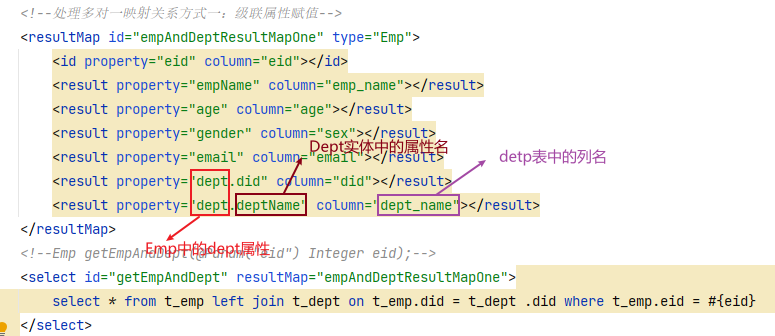 !
!




